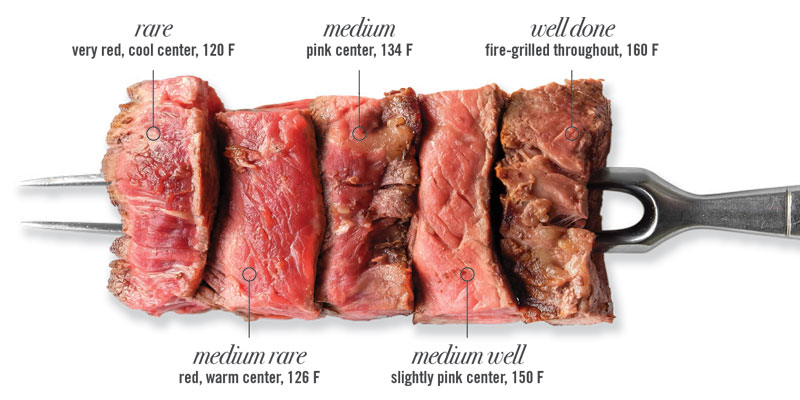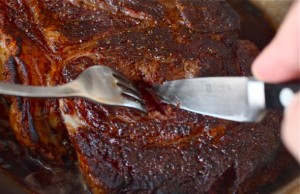Use a thermometer! Yes, you may look a bit less macho when you whip out a nifty Instant Read Thermometer from your back pocket, swing out the slender probe and insert it gently into the very center of your steak to register a reading, but believe me: Perfectly cooked meat will earn you more praise and appreciation than macho posturing any day of the week.
Most like their meat at around 130°F—medium-rare point. Many folks like their meat rare. If you do you want to at least cook until your fats are warm enough that it starts melting a bit, lubricating your meat and adding flavor and juice to every bite. With meat that’s too rare, your fat remains solid. You end up with all the calories and not nearly as much flavor.
On the opposite end of the spectrum with medium-well to well-done meat, not only have your juices been squeezed dry like water from a sponge, but your liquefied fat has already bought itself a one way ticket to the bottom of your grill.
Remember: Thick steaks will continue to rise in temperature after you pull them off of the grill. Heat from the exterior layers will travel in as your steak rests. Make sure to pull it off the grill a good five degrees before you reach your final target.
But what if I don’t have a thermometer?
I get it. Not everyone has a thermometer and they can get expensive and what if you’re stuck in the woods with no thermometer in hand? Is there anything you can do?
Try the Finger Test to Check the Doneness of Meat
There are two basic methods to test for how done your meat is while you are cooking it – use a meat thermometer, or press on the meat with your finger tips. The problem with the meat thermometer approach is that when you poke a hole into the meat with a thermometer, it can let juices escape, juices that you would rather have stay in the meat. For this reason, most experienced cooks rely on a “finger test” method, especially on steaks (whole roasts are better tested with a thermometer). This really isn’t rocket science.
This is one of those things that gets easier with practice. The next time you cook a steak, even if you are still planning to rely on a meat thermometer, press on the meat here and there while it cooks, and compare the feeling of the meat with the following finger test. With practice, you will become more confident.
The Finger Test to Check the Doneness of Meat Recipe

Open the palm of your hand. Relax the hand. Take the index finger of your other hand and push on the fleshy area between the thumb and the base of the palm. Make sure your hand is relaxed. This is what raw meat feels like. (Check this out the next time you have a raw steak to cook.)

Now gently press the tip of your pinky and your thumb together. Again feel the fleshy area below the thumb. It should feel quite firm. This is what well done meat feels like when you press on it. (Check this out the next time you overcook a piece of meat.)

Press the tip of your ring finger and your thumb together. The flesh beneath the thumb should give a little more. This is what meat cooked to a medium doneness feels like.

Gently press the tip of your middle finger to the tip of your thumb. This is medium rare.

Press the tip of your index finger to the tip of your thumb. The fleshy area below the thumb should give quite a bit. This is what meat cooked to rare feels like. Open up your palm again and compare raw to rare.
When all else fails just go ahead and cut the sucker open to take a peek.
I know that everyone tells you you shouldn’t poke the meat lest you “risk losing valuable juices,” but honestly, the loss is not much. Certainly not enough for you to notice once the steak is done. And given the alternative (overcooked meat that will have lost a noticeable amount of juice), it’s the best alternative out there.



